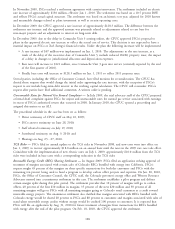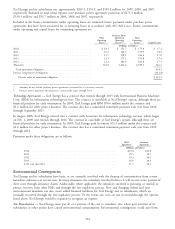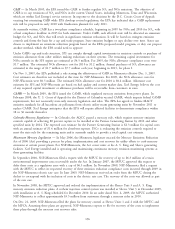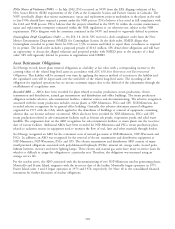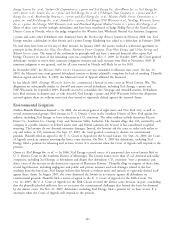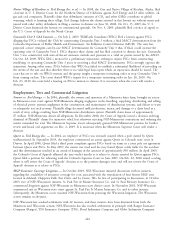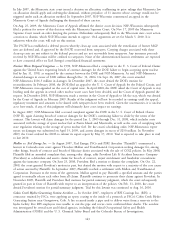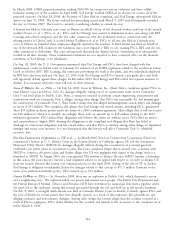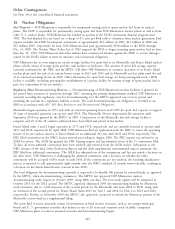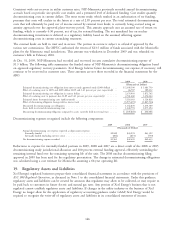Xcel Energy 2009 Annual Report Download - page 146
Download and view the complete annual report
Please find page 146 of the 2009 Xcel Energy annual report below. You can navigate through the pages in the report by either clicking on the pages listed below, or by using the keyword search tool below to find specific information within the annual report.CAIR — In March 2005, the EPA issued the CAIR to further regulate SO2 and NOx emissions. The objective of
CAIR is to cap emissions of SO2 and NOx in the eastern United States, including Minnesota, Texas and Wisconsin,
which are within Xcel Energy’s service territory. In response to the decisions by the D.C. Circuit Court of Appeals
vacating but reinstating CAIR while EPA develops revised regulations, the EPA has indicated that a CAIR replacement
rule will be proposed in early 2010 with finalization planned for early 2011.
As currently written, CAIR has a two-phase compliance schedule, beginning in 2009 for NOx and 2010 for SO2, with
a final compliance deadline in 2015 for both emissions. Under CAIR, each affected state will be allocated an emissions
budget for SO2 and NOx that will result in significant emission reductions. It will be based on stringent emission
controls and forms the basis for a cap and trade program. State emission budgets or caps decline over time. States can
choose to implement an emissions reduction program based on the EPA’s proposed model program, or they can propose
another method, which the EPA would need to approve.
Under CAIR’s cap and trade structure, SPS can comply through capital investments in emission controls or purchase of
emission allowances from other utilities making reductions on their systems. The remaining capital investments for
NOx controls in the SPS region are estimated at $4.5 million. For 2009, the NOx allowance compliance costs were
$1.7 million. The estimated NOx allowance cost for 2010 is $1.2 million. Annual purchases of SO2 allowances are
estimated in the range of $1.7 million to $7.7 million each year, beginning in 2013, for phase I.
On Nov. 3, 2009, the EPA published a rule staying the effectiveness of CAIR in Minnesota effective Dec. 3, 2009.
Cost estimates are therefore not included at this time for NSP-Minnesota. For 2009, the NOx allowance costs for
NSP-Wisconsin were $0.5 million. The estimated NOx allowance cost for 2010 is $0.4 million. Allowance cost
estimates for SPS and NSP-Wisconsin are based on fuel quality and current market data. Xcel Energy believes the cost
of any required capital investment or allowance purchases will be recoverable from customers in rates.
CAMR — In March 2005, the EPA issued the CAMR, which regulated mercury emissions from power plants. In
February 2008, the U. S. Court of Appeals for the District of Columbia vacated CAMR, which impacts federal CAMR
requirements, but not necessarily state-only mercury legislation and rules. The EPA has agreed to finalize MACT
emission standards for all hazardous air pollutants from electric utility steam generating units by November 2011 to
replace CAMR. Xcel Energy anticipates that the EPA will require affected facilities to demonstrate compliance within
18 to 36 months thereafter.
Colorado Mercury Regulation — In Colorado, the AQCC passed a mercury rule, which requires mercury emission
controls capable of achieving 80 percent capture to be installed at the Pawnee Generating Station by 2012 and other
specified units by 2014. The expected cost estimate for the Pawnee Generating Station is $2.3 million for capital costs
with an annual estimate of $1.4 million for absorbent expense. PSCo is evaluating the emission controls required to
meet the state rule for the remaining units and is currently unable to provide a total capital cost estimate.
Minnesota Mercury Legislation — In May 2006, the Minnesota legislature enacted the Mercury Emissions Reduction
Act of 2006 (Act) providing a process for plans, implementation and cost recovery for utility efforts to curb mercury
emissions at certain power plants. For NSP-Minnesota, the Act covers units at the A. S. King and Sherco generating
facilities. Xcel Energy installed and is operating and maintaining continuous mercury emission monitoring systems at
these generating facilities.
In September 2006, NSP-Minnesota filed a request with the MPUC for recovery of up to $6.3 million of certain
environmental improvement costs recoverable under the Act. In January 2007, the MPUC approved this request to
defer these costs as a regulatory asset with a cap of $6.3 million. In November 2008, NSP-Minnesota filed a request
with the MPUC to reflect its requested recovery of these emission reduction compliance costs incurred through 2009 in
the NSP-Minnesota electric rate case. In June 2009, NSP-Minnesota received an order from the MPUC closing the
docket to correspond with the inclusion of costs in the electric rate case. The recovery of the costs was allowed as part
of the rate case.
In November 2008, the MPUC approved and ordered the implementation of the Sherco Unit 3 and A. S. King
mercury emission reduction plans. A sorbent injection control system was installed at Sherco Unit 3 in December 2009,
with installation at A. S. King scheduled for December 2010. In an order dated Nov. 4, 2009, the MPUC authorized
NSP-Minnesota to collect approximately $3.5 million from customers through a mercury rider in 2010.
On Dec. 21, 2009, NSP-Minnesota filed the plans for mercury control at Sherco Units 1 and 2 with the MPUC and
the MPCA. Assuming these plans are approved, NSP-Minnesota expects to file for recovery of the costs to implement
these plans through the mercury cost recovery rider.
136




